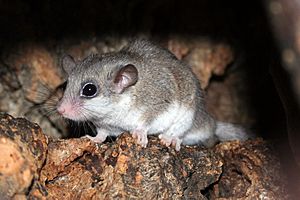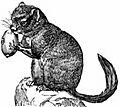Dormouse facts for kids
Quick facts for kids Dormouse |
|
|---|---|
 |
|
| African dormouse, Graphiurus sp. | |
| Scientific classification | |
| Kingdom: | |
| Phylum: | |
| Class: | |
| Order: | |
| Suborder: | |
| Family: |
Gliridae
Muirhead in Brewster, 1819
|
| Subfamilies and Genera | |
Dormice are small, furry animals that belong to the rodent family called Gliridae. You can find them mostly in Europe, but some also live in Africa and Asia. They are famous for sleeping for a very long time, which is called hibernation. In places like the British Isles, when people say "dormouse," they usually mean the hazel dormouse, which is just one type of dormouse.
Contents
What Makes Dormice Special?
Dormice are small rodents. Their bodies are usually between 6 and 19 centimeters (about 2 to 7.5 inches) long. They weigh between 15 and 200 grams (about 0.5 to 7 ounces). They look a lot like mice, but they have furry tails instead of scaly ones.
Most dormice live in trees. They are very quick and good at climbing. Many species are nocturnal, meaning they are active at night. Dormice have excellent hearing. They use different sounds to talk to each other.
Dormice are omnivores, which means they eat both plants and animals. They usually enjoy fruits, berries, flowers, nuts, and insects. Unlike most other rodents, dormice do not have a special part of their gut called a cecum. This part helps other animals digest plants. Dormice have teeth similar to squirrels, but they often do not have premolars.
Dormice usually have one or two litters of babies each year. They have about four young after being pregnant for 21 to 32 days. Dormice can live for up to five years. When they are born, the babies have no hair and cannot do much for themselves. Their eyes open about eighteen days after birth. They are usually ready to have their own babies after their first hibernation. Dormice live in small family groups. The size of the area they live in depends on the type of dormouse and how much food is available.
The Long Sleep: Hibernation
One of the most interesting things about dormice that live in colder places is their hibernation. Dormice can sleep for six months or even longer if the weather stays cold. Sometimes they wake up for a short time to eat food they stored nearby. During the summer, they eat a lot to store fat in their bodies. This fat gives them the energy they need to survive their long sleep.
The word "dormouse" actually comes from this sleepy habit! The old Anglo-Norman word dormeus means "sleepy one." The word was later changed to sound like "mouse." The sleepy character of the Dormouse in Lewis Carroll's Alice's Adventures in Wonderland also shows this trait.
Dormice and Humans
In ancient Rome, the edible dormouse was considered a special food. People ate it as an appetizer or even as a dessert. For dessert, it would be dipped in honey and poppy seeds. The Romans even had special places called glirarium to keep dormice. Today, dormice are still eaten in Slovenia. In the time of Queen Elizabeth I, people used dormouse fat to help them sleep.
How Dormice Evolved
The oldest fossil evidence of dormice has been found in Europe. These fossils date back to the early Eocene period. They appeared in Africa later, during the upper Miocene period. Their arrival in Asia was even more recent. Many types of dormouse species that are now extinct have been found. During the Pleistocene Ice Age, giant dormice lived on the islands of Malta and Sicily. These dormice, like Leithia melitensis, were as big as large rats!
Types of Dormice
The dormouse family, Gliridae, includes 34 living species. These are grouped into three main subfamilies and 10 genera. Not all scientists agree on the exact number, but here are some examples:
- Subfamily Graphiurinae
- Genus Graphiurus (African dormouse)
- Example: Graphiurus murinus (Woodland dormouse)
- Genus Graphiurus (African dormouse)
- Subfamily Leithiinae
- Genus Chaetocauda
- Example: Chaetocauda sichuanensis (Chinese dormouse)
- Genus Dryomys
- Example: Dryomys nitedula (Forest dormouse)
- Genus Eliomys (Garden dormice)
- Example: Eliomys quercinus (Garden dormouse)
- Genus Muscardinus
- Example: Muscardinus avellanarius (Hazel dormouse)
- Genus Chaetocauda
- Subfamily Glirinae
- Genus Glirulus
- Example: Glirulus japonicus (Japanese dormouse)
- Genus Glis
- Example: Glis glis (Edible dormouse)
- Genus Glirulus
Images for kids
See also
 In Spanish: Glíridos para niños
In Spanish: Glíridos para niños



